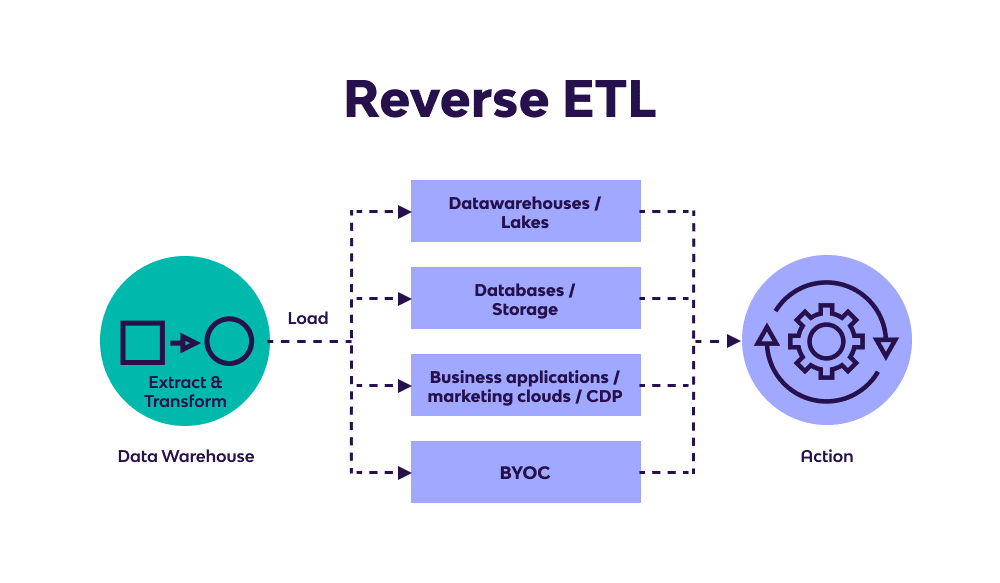
What do Reverse ETL tools do?

What is Reverse ETL?
Reverse ETL, also known as data unloading or data extraction, is a process that copies data from a repository like a data warehouse into platforms like analytics and automation software. It updates apps with accurate, real-time data from the cloud.
Reverse ETL broadly works in the opposite way as the ETL process, taking data that's stored in a cloud warehouse and pushing it out to individual SaaS applications and other platforms.
What do Reverse ETL tools do?
Reverse ETL solutions extract information from a data warehouse and load it into business applications.
While Reverse ETL tools are not truly reversing the ETL process, they have been named as such because they offer mirrored capabilities to traditional ETL (extract, transform, load) tools that extract information from business applications and load it into data warehouses.
Reverse ETL helps organizations streamline their data operations -- it's become a vital part of any data workflow for business teams that rely on cloud data storage.
ETL vs. Reverse ETL: What's the difference?
The main difference between
ETL and Reverse ETL
is the direction of the data flow.
ETL moves data from various sources into a repository like a data warehouse, while Reverse ETL moves data from a central location into other systems.
ETL stands for extract, transform, load. It's the traditional workflow to extract raw data from sources, load it into a cloud data warehouse, then use data transformations to improve it.
Reverse ETL takes that data and copies it into other platforms, like a CRM like Salesforce or a business intelligence tool like Tableau.
Reverse ETL: What business value does it provide?
- Reverse ETL provides value to organizations through better data activation, automation, and accuracy. The role of Reverse ETL as a data integration tool is to move cleaned, transformed data back into the platforms where it'll be used.
- The primary benefit of Reverse ETL is activating data that would otherwise stay siloed in a data warehouse or on-premise SQL database. By making data usable, it allows organizations to access accurate data in real-time dashboards and workflows and make data-driven decisions faster.
- Reverse ETL processes can also let companies bring stored data into their operational systems, such as CRMs or marketing automation platforms. When combined with an ETL/ELT tool, Reverse ETL helps eliminate data silos and provides a single source of truth.
What's the role of Reverse ETL in the Modern Data Stack?
- Reverse ETL plays a crucial role in the modern data stack by bridging the gap between data infrastructure and business tools. It unlocks data stored in data lakes or data warehouses and delivers it to data engineers and other stakeholders.
- This data can be used for operational analytics, marketing campaigns, sales, and more. It enables businesses to move data into real-time dashboards, BI tools, and other platforms for real-time analysis and insights.
- Reverse ETL is an essential part of the data infrastructure, connecting different parts of the data stack and enabling real-time data delivery.
How to Evaluate Reverse ETL Solutions
Reverse ETL solutions have become more popular as organizations look to streamline data workflows and improve data accuracy. But with so many options available, it can be difficult to know which solution is right for you.
Here are the most important factors to consider when choosing a Reverse ETL tool.
1. Cloud-based or On-Premises
Perhaps the biggest deciding factor when evaluating reverse ETL solutions is whether you want to use cloud software or an on-premises solution.
Cloud solutions are often software-as-a-service (SaaS) and typically require less setup and maintenance, while on-prem solutions provide greater control over data security and privacy.
But unless you're a large organization with very specific needs, a cloud-based solution is almost certainly the better option. It integrates best with managed data warehouses like Google BigQuery, Amazon Redshift, or Snowflake and offers improved scalability and lower maintenance than on-premises options.
2. Batch or real-time data support
You'll need to decide whether you want to use real-time or batch processing for Reverse ETL. Look for a solution that offers the speed and method that works best for your data flows.
3. Integration with Existing Tools
You already have a tool stack, and before deciding on a Reverse ETL solution, you need to consider how well it will integrate with it. Most major platforms like Fivetran or Airbyte offer connections to major tools like Slack, HubSpot, Salesforce, or Marketo.
But long-tail tools aren't so easy to find. In the past, data teams needed to write their own custom API integrations. But today, you can find a solution with pre-built connectors to the data sources you need to integrate with.
4. Ease of Use
The easier a Reverse ETL solution is to adopt, the more likely your organization will start---and keep---using it. Consider how easy it is for data teams, marketing teams, and other relevant departments to implement the tool and whether it requires extensive training.
5. Customer Success and Support
Finally, look at the quality and level of customer support the Reverse ETL vendor provides. Consider the level of support provided and the channel---through phone, email, or chat---as well as available hours and what others have said on third-party review sites.